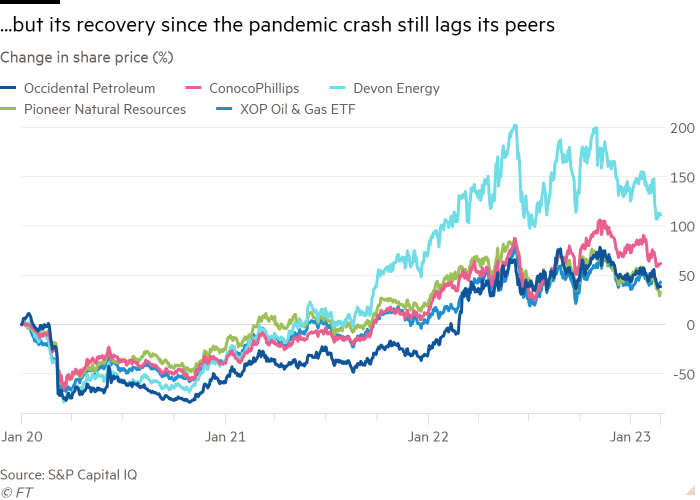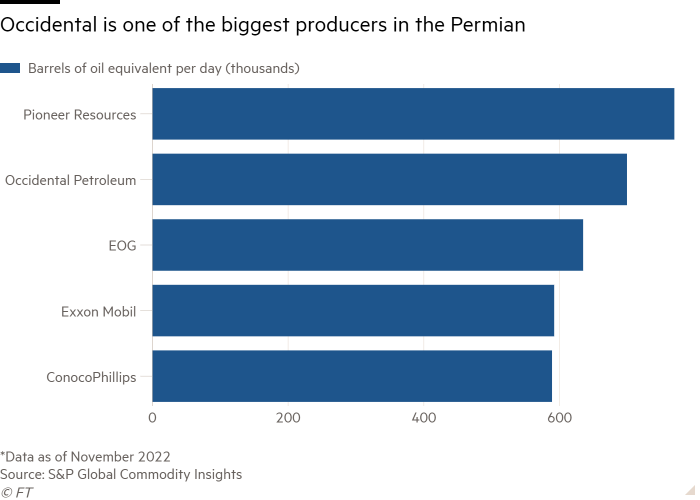When Vicki Hollub flew Occidental Petroleum’s Gulfstream V jet to Omaha for a meeting with billionaire investor Warren Buffett in April 2019, she needed cash to place a bet.
The $10bn cheque with which she emerged allowed her to outbid rival Chevron in an epic corporate battle to acquire Anadarko Petroleum, doubling Occidental, better known as Oxy, in size. But the takeover saddled the company with debts totalling almost $50bn. For the gamble to pay off, oil prices needed to remain elevated.
Things quickly started to go wrong. A little over six months later, as the Covid-19 រាតត្បាត upended the global economy, oil prices began a collapse in which the US benchmark would trade below zero — down as much as 177 per cent from the price on the day the Anadarko deal closed.
Oxy’s stock was demolished by a market that had already soured on an industry that had burnt through investor cash in a series of debt-funded drilling sprees with little to show in the way of returns. Critics panned Hollub for recklessness in ploughing ahead without regard for cost.
“It was the dumbest deal in history,” said one senior oil executive.

Almost four years later, Oxy is not only back from the dead, it is thriving. The company was the best performer on the S&P 500 in 2022, with its stock rising 119 per cent, as it reaped the rewards of elevated oil and gas prices in the wake of Russia’s invasion of Ukraine.
When it reports 2022 earnings on Monday, analysts expect Hollub to unveil the company’s most profitable year ever, with a net income of almost $13bn — roughly double its previous record.
The cash haul has allowed Oxy to pay down almost half of the debt it took on to win Anadarko. Having soared to $39bn after the takeover, long term debt levels had been halved to $19bn as of September 2022. The company’s market capitalisation, which collapsed to less than $10bn after the Covid-19 pandemic, has recovered to $54bn — higher than pre-deal levels.
It is a stark turnround for a company that many feared was facing bankruptcy just three years ago as it led the US shale patch in slashing its dividend and cutting spending.

The criticism of both Oxy and Hollub had been intense. Chevron had emerged from the clash with a $1bn kill-fee, with chief executive Mike Wirth insisting his company was not “desperate” to do a deal to acquire Anadarko. Billionaire investor Carl Icahn, meanwhile, branded the transaction “one of the worst disasters in financial history” as he launched an activist campaign seeking to unseat Hollub. Icahn did not respond to a request for comment.
But as the oil price has rebounded so too have Oxy’s fortunes.
“Sometimes it’s better to be lucky than good,” said Andrew Gillick, a director at consultancy Enverus. “Crude is 80 bucks and everything’s OK now — so it worked out. Should we have expected it to work out? I don’t know, but one can argue that Oxy benefited more than any other energy company from the rebound in oil-price expectations since 2020.”
Today Occidental is the second biggest oil and gas producer in the US’s prolific onshore oilfields. Its so-called inventory of promising areas to drill is among the biggest in the shale patch — an advantage in a sector where rising costs mean scale is becoming increasingly important, say analysts.

“Oxy put itself in a good position by getting bigger at the right time,” said Raoul LeBlanc, vice-president for upstream oil and gas at S&P Global Commodity Insights. “While it took on an enormous amount of debt and required some deft dealmaking, given where prices have gone, it looks like a great deal.”
Elevated prices, said LeBlanc, mean Anadarko has “just turned into a giant ATM to repay the debt”.
For some, the turnround is a vindication of Hollub’s strategy. Hollub declined to be interviewed for this article. Criticism of the deal was also often laced with misogyny in a male-dominated shale patch.
“I felt like the media unfairly characterised Vicki personally,” said Katie Menhert, chief executive of Ally Energy. “If she had been Victor . . . had she been a man, would this have been the dramatic situation it was?”
Today, analysts are more interested in the group’s pivot into carbon capture. Oxy reckons its expertise in enhanced oil recovery — in which carbon dioxide is injected into the earth to release more oil — will give it a leg-up as the world scrambles to find ways to store carbon back underground.

The move has made the company a major beneficiary of the Inflation Reduction Act, Joe Biden’s sweeping $369bn climate law, which pumps huge funds into carbon capture and storage. But the shift, which includes a $1bn investment on as-yet unproven direct air capture, is also another gamble for Hollub, analysts say.
With Buffett on board, Hollub has access to one of the best capitalised balance sheets in the world. His involvement at the time of the deal was critical: the use of preferred shares helped safeguard Oxy’s credit ratings while also avoiding the need for a shareholder vote on the takeover, something the Anadarko board refused to entertain.
Berkshire has since scooped up far more of Oxy, buying more than 20 per cent of its common stock in the open market. The purchases have fuelled speculation that Berkshire could one day make a full-throated play for the US oil company, in part because Buffett’s company has won approval to buy up to half of Oxy.
“He really likes her and feels like she is a super high quality chief executive,” Jim Shanahan, an analyst at Edward Jones, said of Buffett’s view of Hollub. “Perhaps there is a link he sees to combine interests” between Oxy and Berkshire’s own energy and utility businesses.
But there are clouds on the horizon. Shale producers, including Oxy, have successfully ridden a wave of rising oil prices since Russian troops spilled into Ukraine. But those prices have been steadily drifting lower in recent months. And banking on supplying more oil in a world otherwise needing to curb its consumption of fossil fuels remains the biggest gamble of all.
Hollub was unlucky that a global pandemic arrived just at the wrong time. But she has been fortunate that an invasion has helped rescue her company’s stock price too.
“Oxy weathered the storm,” said LeBlanc. “And it is in a pretty strong position both in its core business and with the risks that they’re taking. I don’t know if those risks are going to pan out — but they’re in a pretty good position in terms of their approach and strategy — and on the execution — so far.”
Additional reporting by Amanda Chu
Source: https://www.ft.com/cms/s/67c58425-776c-4ff4-97eb-36a9acd68378,s01=1.html?ftcamp=traffic/partner/feed_headline/us_yahoo/auddev&yptr=yahoo
